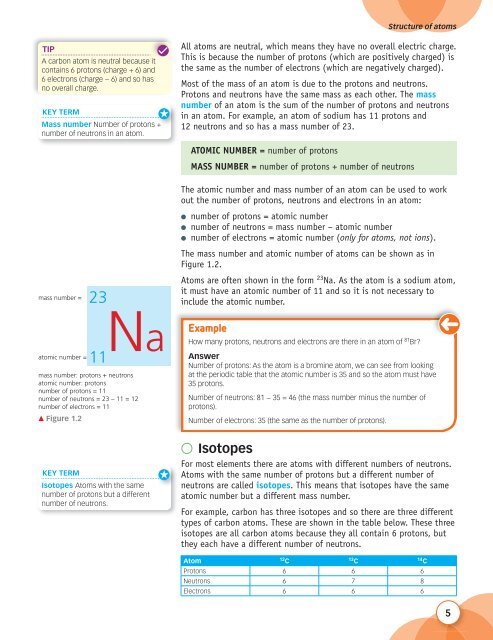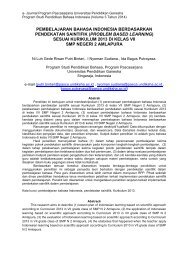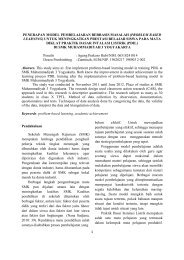Create successful ePaper yourself
Turn your PDF publications into a flip-book with our unique Google optimized e-Paper software.
Structure of atoms<br />
TIP<br />
A carbon atom is neutral because it<br />
contains 6 protons (charge + 6) and<br />
6 electrons (charge − 6) and so has<br />
no overall charge.<br />
KEY TERM<br />
Mass number Number of protons +<br />
number of neutrons in an atom.<br />
All atoms are neutral, which means they have no overall electric charge.<br />
This is because the number of protons (which are positively charged) is<br />
the same as the number of electrons (which are negatively charged).<br />
Most of the mass of an atom is due to the protons and neutrons.<br />
Protons and neutrons have the same mass as each other. The mass<br />
number of an atom is the sum of the number of protons and neutrons<br />
in an atom. For example, an atom of sodium has 11 protons and<br />
12 neutrons and so has a mass number of 23.<br />
mass number =<br />
23<br />
ATOMIC NUMBER = number of protons<br />
MASS NUMBER = number of protons + number of neutrons<br />
The atomic number and mass number of an atom can be used to work<br />
out the number of protons, neutrons and electrons in an atom:<br />
● number of protons = atomic number<br />
● number of neutrons = mass number – atomic number<br />
● number of electrons = atomic number (only for atoms, not ions).<br />
The mass number and atomic number of atoms can be shown as in<br />
Figure 1.2.<br />
Atoms are often shown in the form 23 Na. As the atom is a sodium atom,<br />
it must have an atomic number of 11 and so it is not necessary to<br />
include the atomic number.<br />
atomic number =<br />
mass number: protons + neutrons<br />
atomic number: protons<br />
number of protons = 11<br />
number of neutrons = 23 – 11 = 12<br />
number of electrons = 11<br />
▲ Figure 1.2<br />
KEY TERM<br />
11Na<br />
Isotopes Atoms with the same<br />
number of protons but a different<br />
number of neutrons.<br />
Example<br />
How many protons, neutrons and electrons are there in an atom of 81 Br?<br />
Answer<br />
Number of protons: As the atom is a bromine atom, we can see from looking<br />
at the periodic table that the atomic number is 35 and so the atom must have<br />
35 protons.<br />
Number of neutrons: 81 − 35 = 46 (the mass number minus the number of<br />
protons).<br />
Number of electrons: 35 (the same as the number of protons).<br />
● Isotopes<br />
For most elements there are atoms with different numbers of neutrons.<br />
Atoms with the same number of protons but a different number of<br />
neutrons are called isotopes. This means that isotopes have the same<br />
atomic number but a different mass number.<br />
For example, carbon has three isotopes and so there are three different<br />
types of carbon atoms. These are shown in the table below. These three<br />
isotopes are all carbon atoms because they all contain 6 protons, but<br />
they each have a different number of neutrons.<br />
Atom 12 C 13 C 14 C<br />
Protons 6 6 6<br />
Neutrons 6 7 8<br />
Electrons 6 6 6<br />
5





